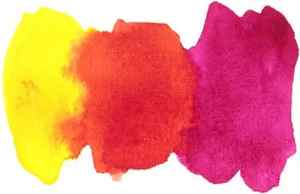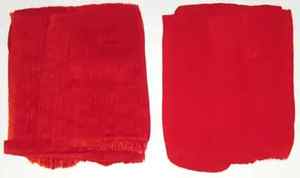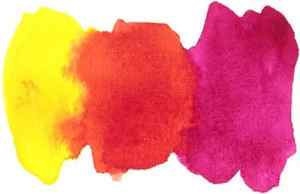I tried it with alizarin crimson, which is a cool red, but it didn’t work as well. (It did produce a muted red, which might be what you’re looking for…)
How to Mix Red Paint: Yes It’s Possible!

I’m a self-taught artist who loves sharing tips and tutorials for painting with watercolor and gouache, and using the Procreate app on the iPad.
Did you know that you can mix red paint? Learn how to mix red paint from 2 colors. This will allow you to keep a limited color palette or to save money when you start painting!
You might also like this post on color theory.
This post contains affiliate links. By purchasing an item through an affiliate link, I earn a small commission at no extra cost to you. As an Amazon Associate I earn from qualifying purchases.
I’ve included links to Blick where available because they often have better prices than Amazon. Plus, it’s so much fun to shop at Blick!
Fun with Color Mixing
One of the first things that you learn in school is the primary colors: red, yellow, and blue. We are taught that these are primary colors because no other colors can make them.
Did you know that this isn’t true for red? It is possible to make red paint from other colors.
As I learn more about painting, I’m learning that everything we were taught in school is pretty much wrong.
Paint mixing is way more complicated than those simple rules. (Yesterday I mixed green and red and it made purple! What. )
Playing with color mixing is one of my favorite things to do. It’s a great thing to play with when you want to paint, but don’t know what to paint.
Mix colors that aren’t supposed to go together and you will be shocked at the results!
Mixing Red Paint
If you have a cool red (magenta or pinkish color) and a yellow, you can make red! It will never be the super bright red of cadmium, but I rarely use that color anyways.
Why does this work?
The “primary color” method is based on mixing additive colors, like ink or opaque paints.
Using magenta and yellow to make red is based on mixing subtractive colors, similar to how light works. This is also how your printer makes colors.
Have you ever looked at the color names: magenta, yellow, and cyan?
Those 3 colors plus black can make millions of colors. There’s no red or blue because those colors can be made from magenta, yellow, and cyan.
Watercolor is transparent, so it has properties similar to light. Some acrylics are also pretty transparent, so this works to some degree.
This is great to know if you want to work with a very limited palette.
Buy a cool red, a cool yellow, and blues. For blue, I would probably go with a warm blue and a cool blue. If you are using watercolors, add a Paynes Gray or neutral tint (vs black.)
If you are working with acrylics, add white and a black or Payne’s gray.
How to Mix Red with Acrylic Paint
Mixing red is very simple, just add yellow to magenta. The only part that you have to pay attention to is the proportions. It’s best to start with a pile of Quinacridone Magenta and slowly add the Hansa Yellow Medium to it until it shifts from magenta to red. The proportions are about 80% magenta to about 20% yellow.
The exact proportions will depend on the brand of your paints and the tinting strength** of each color. It also depends upon if you want your red to be biased towards orange or magenta. You’ll have to experiment with it to find the shade of red you prefer.
Mixed Red Compared to Cadmium Red Medium
After mixing the purest red that I could achieve with magenta and yellow, I thought it would be a good test to compare it to a standard red. Cadmium Red Medium is probably one of the more popular reds, so I chose it for comparison.

It’s a very close match. The main difference is the mixed red is more transparent then the Cadmium Red Medium, as you can tell by the slight streaks in it.


Mixing Red with Watercolors
For the watercolor demonstration, I used the QOR brand of Hansa Yellow Medium and mixed it with Quinacridone Magenta. The transparency of these colors is important because opaque versions of yellow or magenta will result in a weaker reds.

Golden recently replaced their QoR Hansa Yellow Medium because the lightfast testing revealed that it didn’t live up to their standards. It’s been replaced with Benzimidazolone Yellow, which produces similar results when mixed with Magenta.
I also tried mixing Quinacridone Magenta with Aureolin Modern. When I squeezed it from the tube I noticed that it was slightly duller than the Hansa Yellow Medium. However, when I diluted it with water, it produced a fairly bright Yellow. If you mix Quinacridone Magenta with Hansa Yellow Medium it also produces an acceptable red. 

Making Red from Pink and Black
Most basic food coloring packs include red, yellow, blue, and green. From those colors, you should be able to mix most of the other colors you want to use.
However, some brands do make more variety of colors. This can save you time on painstakingly mixing your colors.
If you have one of those expanded packs and you are out of red food coloring, you can mimic red by adding pink food coloring and black.
Start with only a small amount of black, as adding black can quickly change the shade of the food coloring.
Depending on what you are making, you may not even need to add black food coloring.
For example, if you are making a devil’s food cake and you want to add the red food coloring to help achieve the signature color of the cake, you can substitute pink.
The cake itself is dark enough that if you have pink food coloring, it will give your cake the iconic devil’s food color.
How to Make Different Colors of Food Coloring
The following list explains which colors you will need to mix to achieve various secondary colors and more. Adding more or less of any color can help you add more nuance and variety, given your vision.
- Green- Add blue and yellow. Since most blue food colors are more saturated than the yellow dyes, you may want to add more yellow than blue. Start with equal parts and add more blue or yellow depending on which shade you want.
- Purple- If you want a true purple, add equal parts of blue and red food coloring.
- Orange- To create a true orange, add equal parts of yellow and red food dye.
- Plum- If you want a plum color, you will want to add blue and red food dye. Add more red dye than you add blue because plum is a reddish-purple.
- Teal- If you want teal or turquoise, you should add blue and green food dye. If you do not have green food dye in your kit, you can add blue and yellow but making sure to add twice as much blue as yellow.
- Apricot or coral- Start with yellow food coloring. Slowly add a little red or pink (depending on what you have) until you have the shade of coral you are looking for.
Natural Substitutes for Red Food Coloring
If you are out of red food coloring and you are interested in making your own, there are other options! Similarly, some people do not like to use chemicals in food coloring.
This natural substitution will still give you the color you want, without food coloring.
Beet Juice
Beet juice is a popular substitute for red food coloring. It is inexpensive and relatively easy to make.
All you need to do to use beet juice as a food coloring is wash a beet and grate it into a paper towel.
If the beet is fresh and juicy enough, you can just squeeze the juice from those grated chunks directly into whatever you are coloring.
If you want more beet juice or if you are concerned about not getting enough juice from your beet, you can make some beet juice by boiling beets.
Simply peel the beets, add them to water and let the water simmer until the beets are no longer bright red. Then, add a little bit of sugar and dissolve it in the beet juice.
Remove the beets and let the dye cool before adding it to your recipes.
How to Make Red Frosting >> Check out the video below:





